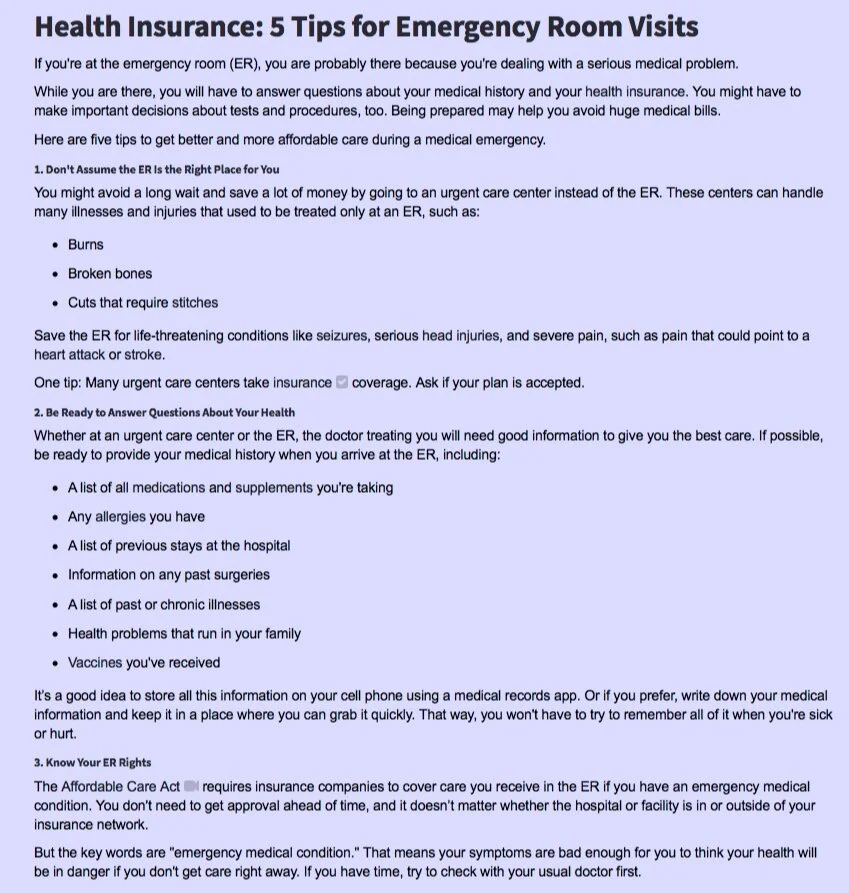Medical Issues
Medical Insurance
Your medical insurance can be found in your online application. If you have trouble viewing it, contact your agency in your home country.
You will need to show your insurance information when seeking medical treatment.
You may need your insurance information when you don’t have internet access or when your phone is out of battery. We recommend keeping a photo of your insurance information in your phone, and also printing your insurance information and keeping it in your wallet.
In the U.S. having medical insurance doesn't mean that all services are free. Most insurance policies will charge you a large fee if you go to the emergency room for a non-emergency. Also, you may have to pay a small fee, called a co-pay, any time you seek medical attention.
Ensure your insurance covers you from the day you leave your home country until the day that you return home. If you need medical attention in the U.S. on a day that you are not covered by insurance, you and your family could receive medical bills in the hundreds of thousands of dollars. Taking a risk with insurance could be a financial burden for the rest of your life.
The Four Kinds of Medical Facilities
Doctor's Office
Your insurance has a list of specific doctors (also known as Primary Care Physicians) that can be used for a low cost or no cost. This can be less expensive than Urgent Care if there is time to make an appointment - for example, to get medicine for a cold or rash that won't go away, or to get a refill on a prescription, or for a minor infection. Always contact your insurance company or visit your insurance website to find a doctor. If you visit a doctor that is not covered by your insurance, the bill can be hundreds of dollars.
Walk-In Clinic
Work & Travel participants would most commonly use a Walk-In Clinic for services that are not covered by their insurance, such as vaccinations, pregnancy tests, getting a prescription for birth control, getting a general physical exam, or even vision care. You will often need to pay for services at a Walk-In Clinic, however, the cost is often lower than at a doctor’s office. Ask about cost before getting care. Walk-In Clinics are often found at drugstores, grocery stores, and supermarkets.
Urgent Care
Urgent Care is the most common health care facility for Work & Travel participants, who are likely to face urgent non-emergencies such as sudden illness or allergic reaction, or a minor accident (broken bone, non-life-threatening cut). The cost may be higher than with a doctor's office. Urgent Care is usually open evenings and weekends, unlike a doctor's office. Ensure they take your insurance before seeking care. Find an Urgent Care center.
Emergency Room
The Emergency Room should only be used when a student believes his/her life may be at risk (trouble breathing, chest pain, severe bleeding, trouble maintaining consciousness). To avoid paying a high fee for using the Emergency Room in a non-emergency, please read the below article when it is appropriate to use the Emergency Room. Find an Emergency Room
Getting Hurt at Work
Your employer has special insurance, called Worker’s Compensation, which covers your medical care if you are injured at work, even if it was your fault. If you are injured at work, tell your employer immediately and ask for a claim form. Then, contact ERDT immediately. It is illegal for the employer to refuse to give you a claim form, or to fire you for having an injury at work, even if it was your fault.
If you are hurt outside of work, and cannot work
If you cannot work due to an illness, or an injury that happened outside of work, your employer can legally fire you. If this happens, ERDT can allow you to stay in the U.S. for 3 weeks to recover and start work again. If you are unable to start work again after 3 weeks, or if you cannot afford to live in the U.S. while not working, ERDT will end your program and you will have 30 days to travel and return home.


